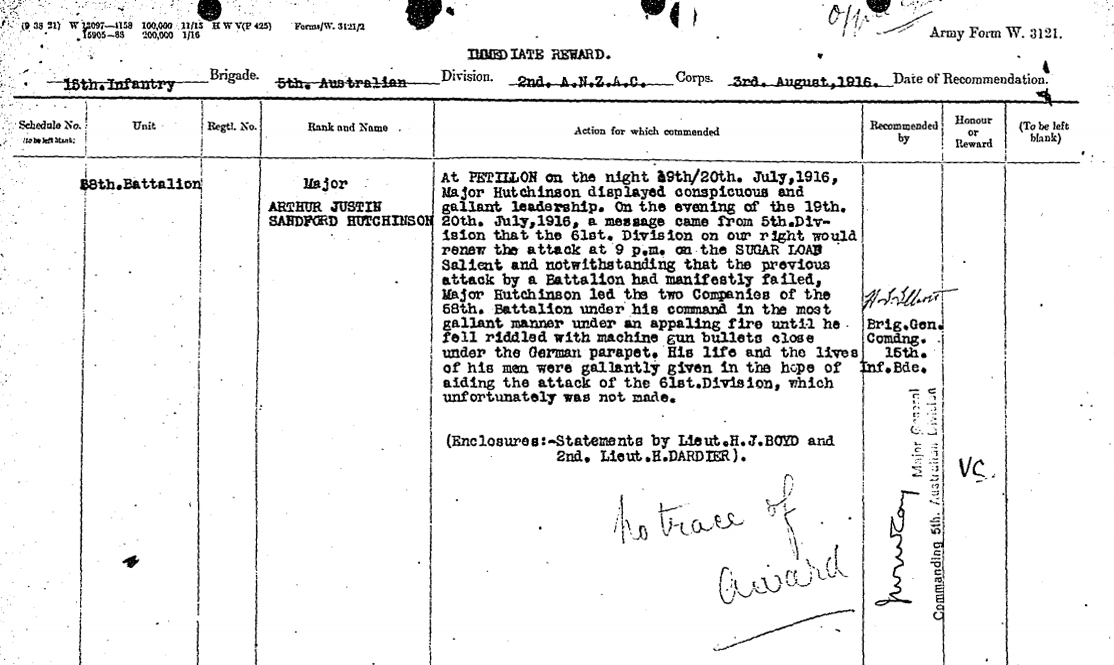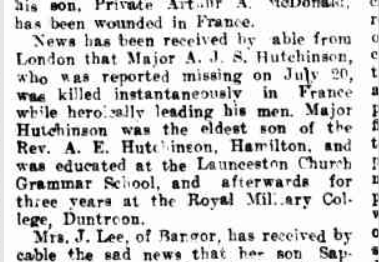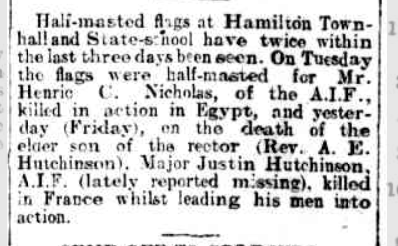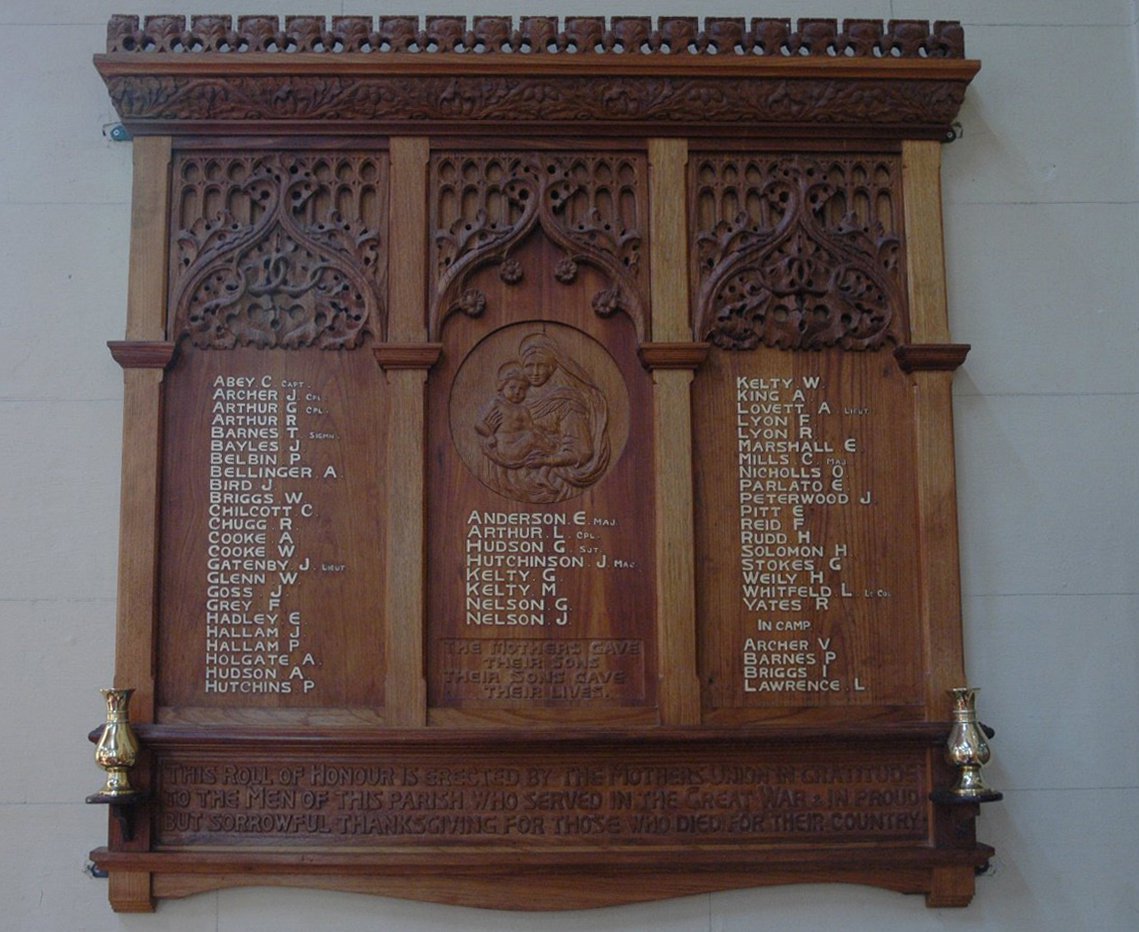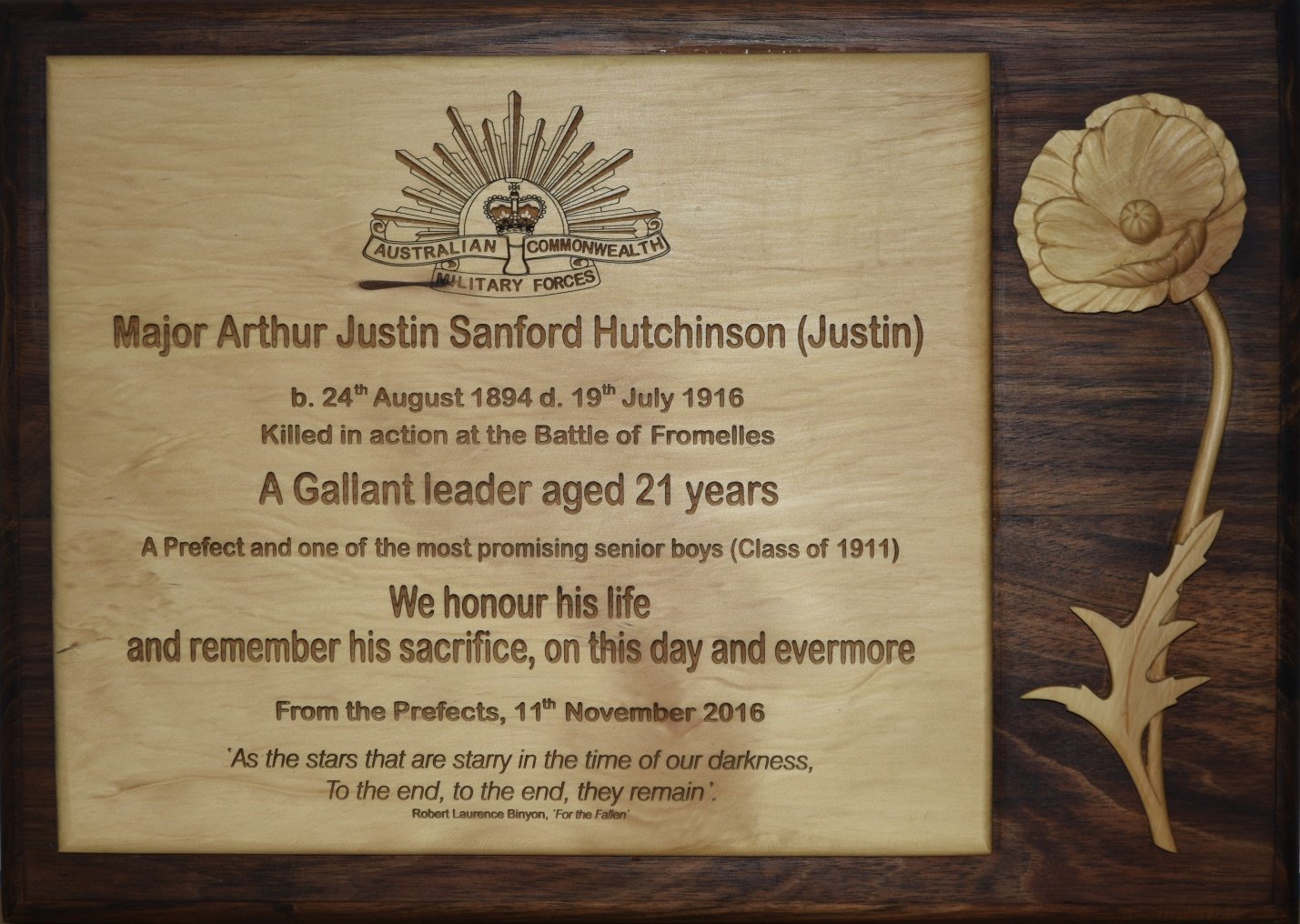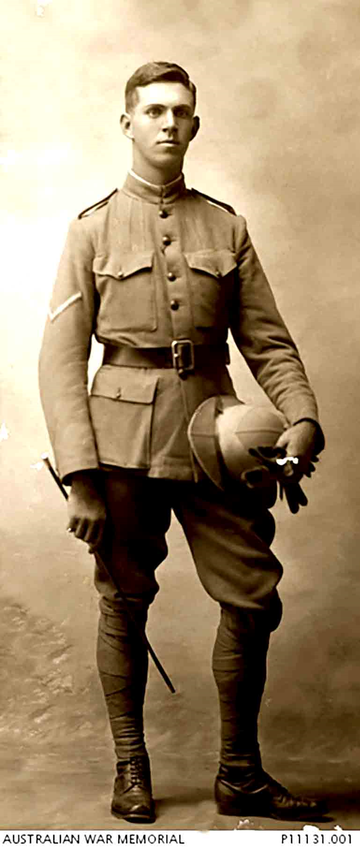
Arthur Justin Sanford HUTCHINSON
Eyes hair unknown, Hair eyes unknown, Complexion unknown
A Gallant Tasmanian Officer
In compiling this story, we acknowledge the work of Geoffrey Benn and Ross McMullin and thank them for their generosity in allowing us access to their work and for sharing their research and written materials.
A 1920 news report gives an insight into the short life of Major Justin Hutchinson, killed just a month shy of his 22nd birthday. Titled Gallant Tasmanian – Major Hutchinson’s Death, it began:
“It will be remembered by the many friends of the Rev. Arthur Hutchinson, rector of the Hamilton parish, that his eldest son (Major Justin Hutchinson) fell in the battle of Fromelles, better known as the attack at Armentieres in July, 1916. For a long time the secrecy of war kept a veil drawn over the details of this sad page in the history of the Australian Imperial Forces. Accounts have now been published telling the story in stirring language of "our most glorious failure." In it the bravery and daring of the young Tasmanian officer (Major Hutchinson) who died gloriously whilst leading his men against tremendous odds, are pictured. The part referring to his gallantry will be read with interest by his many friends:”
The article then quoted an extract from a newly published book (pictured below)
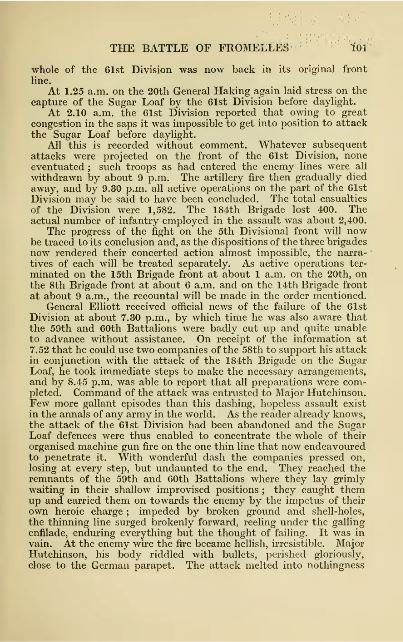
The article then continues:
"Major Hutchinson was only 21 years of age at the time when he made the great sacrifice. He had entered Duntroon Military College three years previous to the war and showed great promise of a distinguished career as a soldier. For his conspicuous bravery he was recommended for the Victoria Cross, but it is thought probable that his commanding officer was killed, as his relatives never received it.”
There were numerous reports from men of the 58th Battalion to the Red Cross confirming the death of Major Justin Hutchinson - apparently a man well-liked and respected - including the following
Pte 3257 George Henry SMYTHE:
“I was with Major Hutchinson as we went across in the charge at Fleurbaix on July 19th. We got across nearly to the first line German trenches and lay down for the next advance. He said, ‘Don’t get too close together boys, spread out in the next run.’ We got up and went forward. As we rose, he was hit and fell (in a heap). I was wounded soon after and managed to crawl back to our lines. When I got back, I heard one of the officers ask a wounded man how Major Hutchinson was getting on. The man replied that he was dead. Evidently he died where I saw him fall.”
Pte 3624 Stanley Gordon PARKER:
“Went over the parapet with us and about half way across I saw him; he got up gave an order and fell back dead – about ½ an hour after I saw him still lying there. I knew he was dead, he was our own Major and very much liked by all the men in the Regiment, he only had his crown about a month.”
Pte 4495 Albert Edward GRAY:
“On July 20th there was a report in the Regiment that during the German bombardment Major Hutchinson was blown to pieces by a shell; his body was not found.”
Pte 324 George Sydney BARNES:
“Informant states that on July 19th 1916, between 10.30 and 10.45 p.m. at Fleurbaix he saw Major Hutchison (sic) hit by a shell in the first trench, of the German lines and killed. He had just got over the trenches and Informant was 5 or 6 yards behind. Informant went over at 10 p.m. in reserve. He had been ordered to go back and get more ammunition and Major Hutchison had given the order to retire, when this occurred. The trenches were lost. Informant states Major Hutchison was his company officer; that he died game, and was a credit to the company”.
The Missing Victoria Cross
Major Hutchinson was recommended for the Victoria Cross but not one soldier who fought at Fromelles was ever awarded that ultimate military honour. There were of course many individual recognitions of honourable action by soldiers in all participating Battalions but the efforts of men like Major Justin Hutchinson stand out as deserving but overlooked for the Victoria Cross. This was despite the efforts and recommendations of senior officers.
Describing Hutchinson, Brigadier Pompey Elliott, his commanding officer, wrote of his energy, competence and enthusiasm combined with a modest and unassuming manner while military historian, Charles Bean, described Major Hutchinson, a Duntroon graduate who led the assault, as a ‘boy of the finest type this country produces.’ (Source: C.E.W. Bean, First World War Official Histories, Volume III, page 394). Hutchinson had led his men forward against the ‘Sugarloaf’ into ‘murderous machine gun fire’ with ‘great dash and resolution’. Indeed, Elliott recommended Hutchinson’s conduct as worthy of a Victoria Cross. The Tasmanian clergyman's son had led his men 'in the most gallant manner under an appalling fire until he fell riddled with machine gun bullets close under the German parapet’, while searching on his own for a gap in the wire.
But Elliott’s recommendation for the VC to be awarded to Hutchinson was denied. Pompey was not surprised. The context was too controversial. Elliott believed there had been a 'shameful betrayal of gallant men' of his brigade who had been 'hopelessly and helplessly massacred'. We know now that the attack should never have been launched and failed due to lack of communication between the Division Headquarters and the Brigade.
By all accounts, Hutchinson had exhibited the gallantry deserving of an award of the Victoria Cross. Instead, as with so many others, he was awarded the 1914-15 Star, the British War Medal, and the Victory Medal.

Justin Hutchinson – a son, a brother, a scholar, a soldier
Although born in Victoria, Arthur Justin Sanford Hutchinson came from strong Tasmanian connections with both his parents born in that state and where, apart from his early infancy, he was raised. He was named for his father, Arthur, a clergyman, but was always known as Justin, a name seemingly chosen to honour his maternal grandfather, Justin McCarty Browne. He was the eldest of seven children born to the family. Two of the children died in infancy and the youngest was born some eighteen months after Justin was killed in the Great War.
Justin was an apt scholar and sportsman at Launceston Church Grammar. He won a university scholarship but made the fateful decision to enlist in the army and train at the Royal Military College at Duntroon instead, against the wishes of his parents.
In 1911, applicants for admission to Duntroon had to contest a series of competitive examinations. English, history, geography, basic mathematics, and general knowledge were all compulsory. Aspirants also had to select two further subjects to be examined in from four options: mathematics, physics, chemistry, and either French or German. The examinations took place in December 1911. With 103 candidates applying from all around Australia, Tasmanian Justin Hutchinson was fourth, scoring 871 out of 1000 marks; he was also the sole Tasmanian to gain entry to the college in that intake.
Hutchinson, aged 17, and his confreres began at Duntroon on 7 February 1912 in the second batch of cadets for the college. His record while at Duntroon shows a few minor disciplinary charges and that he excelled at infantry exercises and maths. On 2 November 1914, he graduated fifth in his class as part of a special graduation for active service. The planned four-year college course was cut short to meet the demands of the war for trained men.
Three years after his entry to Duntroon, he was taken from the college to join the 9th Light Horse Regiment as a lieutenant and left Australia to fight in World War I.
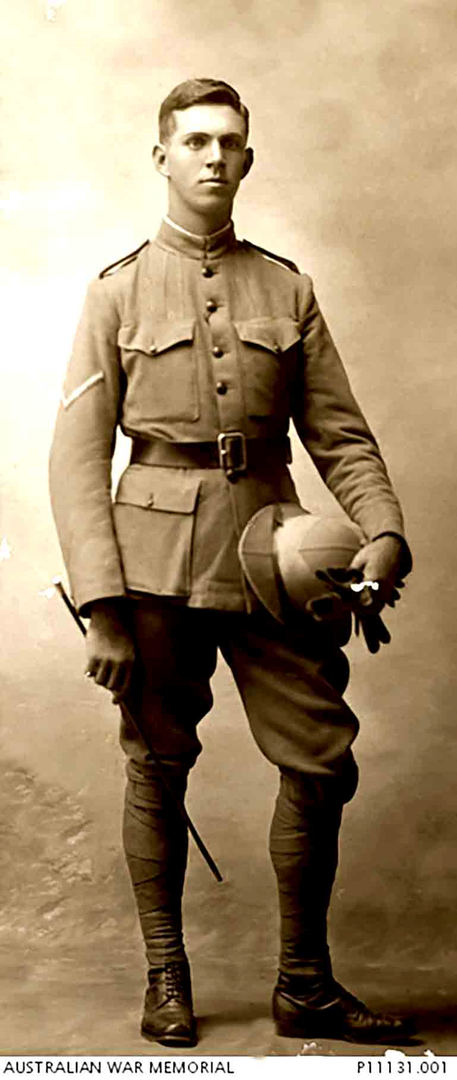
Lieutenant, later Captain, Hutchinson fought in Gallipoli with the 9th Light Horse Regiment, in the machine gun section, and was hampered by illness on several occasions. He experienced a few near misses from bullets - including one that, according to one of his letters – passed through his hair.
Hutchinson would later transfer from the Light Horse to Brigadier Pompey Elliott's 15th Brigade in 1916 and be appointed to lead two companies in the 58th Battalion. He was promoted to the rank of major on 30 May 1916 within two and a half years of overseas service and just seven weeks before his untimely death.
Grieving the Loss
The family at home waited - his parents, Arthur and Lilian, and siblings Dorothy 20, Margaret 11 and Jock 8. Siblings Henry and Rachel had died as infants while Thomas (1918-95) was yet to arrive.
And there was a fiancée – an engagement announced 12 months after Justin had left to fight first in Gallipoli and then Egypt.
In August 1916, Hutchinson’s fiancée, Gladys Forrest of Launceston, wrote to the authorities trying to find out what had happened to him:
"Being engaged to Major A.J.S. Hutchinson, I am naturally very worried at having received a telegram forwarded on to me by Rev. Hutchinson saying ‘Officially reported missing twentieth July, Major A.J.S. Hutchinson, Ninth Light Horse Regiment’.
Having had letters from Egypt of June 3rd date saying he was in command of a company in 58th Battalion, which we since have heard is in France, I am writing to ask if you would be kind enough and can tell me? Is Major Hutchinson now in the 58th Bn in France? Or in Egypt back in the 9th LH? ……. It would help so much in every way, if you would be able to find out any particulars as to if he is still missing, as the anxiety is so great."
It seems clear that delays in notification of Justin’s transfer from the Light Horse to the 58th Battalion and his subsequent move from Egypt to France caused some confusion and gave rise to hope that there may have been some mistake and that the news of his being missing might be incorrect. Sadly, it was not to be, and his death was confirmed by cable just days prior to what would have been his 22nd birthday.
Never Forgotten
DNA donors have come forward from Tasmania and New Zealand and we hope that Justin’s final resting place may one day be confirmed. In the meantime, his life and sacrifice continue to be remembered in a range of ways.
According to Ross McMullin in his book Farewell, Dear People (2012 – pp 229-230), Launceston Grammar School created an avenue of remembrance in 1934 for students who had served and not returned from the Great War. Margaret Challis (mother of George Challis, another who fell at Fromelles) planted a tree in tribute to former students, including Justin Hutchinson and Price Morgan. The tree had originated as a seedling from Gallipoli, as had another 97 trees that were planted in tribute to former students. A speaker at the ceremony said that the trees were a splendid 'way of perpetuating the memory' of these students. Regrettably, the avenue of honour was subsequently demolished.
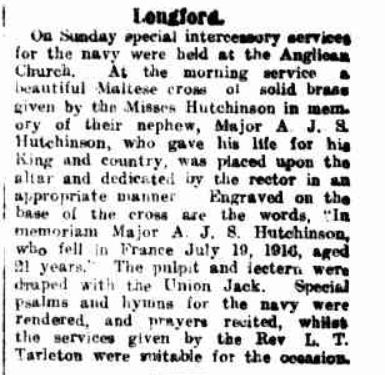
In addition to the memorial cross, Justin’s name is also inscribed on the following memorials:
- Hamilton Municipality Roll of Honour (Honour Board), Tarleton St, Hamilton, Tasmania
- Honour Roll, Christ Church, William St, Longford, Tasmania
- Longford District Honour Roll, Wellington St, Longford, Tasmania
- Longford War Memorial (Cenotaph), Wellington St, Longford, Tasmania
- Major Hutchinson Memorial (carved altar), St Peter’s Anglican Church, Ponsonby St, Hamilton, Tasmania
- Gretna War Memorial, Lyell Highway, Gretna, Tasmania
- Tamar Rowing Club Roll of Honour, South Esk Road, Trevallyn, Tasmania
- Launceston Church Grammar School Roll of Honour, Button St, Mowbray, Tasmania
- Major A. J. S. Hutchinson Memorial, Launceston Church Grammar School, Tasmania
- Panel 13, V. C. Corner Australian Cemetery and Memorial, Fromelles, France
- Panel 165 in the Commemorative Area at the Australian War Memorial, Canberra, ACT
Links to Official Records
Seeking DNA Donors

Contacts
(Contact: carla@fromelles.info or geoffrey@fromelles.info).
(Contact: army.uwc@defence.gov.au or phone 1800 019 090).
Donations
If you are able, please contribute to the upkeep of this resource.
(Contact: bill@fromelles.info ).
